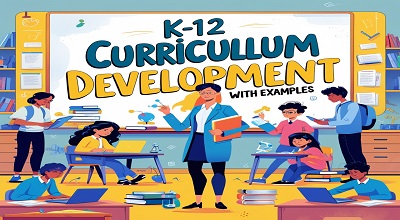K-12 Curriculum Development
K-12 curriculum development is a systematic process of designing, implementing, and evaluating educational programs for students from kindergarten to 12th grade. It involves defining learning objectives, selecting instructional materials, and assessing student progress to ensure a well-rounded education.
The curriculum must align with national and state standards while addressing the diverse needs of learners. With advancements in pedagogy and technology, modern curriculum development emphasises personalised learning, critical thinking, and real-world applications.
Why Is Curriculum Development Important?
- Ensures consistency in education standards
- Adapts to evolving workforce demands
- Supports differentiated learning styles
- Encourages innovation in teaching methods
Key Components of K-12 Curriculum Development
A well-structured K-12 curriculum includes several essential components:
A. Learning Objectives (Standards-Aligned)
- Define what students should know and be able to do
- Follow frameworks like Common Core, NGSS (Next Generation Science Standards), or state-specific guidelines
B. Instructional Materials & Resources
- Textbooks, digital tools, multimedia content
- Hands-on learning kits and real-world problem-solving activities
C. Teaching Strategies & Pedagogical Approaches
- Inquiry-Based Learning – Encourages exploration and questioning
- Project-Based Learning (PBL) – Students work on real-world projects
- Flipped Classroom – Students learn content at home and practice in class
D. Assessment & Evaluation Methods
- Formative assessments (quizzes, discussions)
- Summative assessments (standardized tests, final projects)
- Competency-based assessments (measuring skill mastery)
E. Professional Development for Educators
- Ongoing teacher training on new curriculum updates
- Workshops on integrating technology in classrooms
Latest Trends in K-12 Curriculum Development
A. Personalized & Adaptive Learning
- AI-driven platforms like Khan Academy, DreamBox adjust content based on student performance.
B. Social-Emotional Learning (SEL)
- Programs like CASEL’s SEL Framework teach empathy, resilience, and teamwork.
C. STEM/STEAM Integration
- Combines Science, Technology, Engineering, Arts, and Math
- Example: FIRST Robotics competitions for hands-on engineering experience
D. Culturally Responsive Teaching
- Curriculum includes diverse perspectives (e.g., ethnic studies, global history)
E. Blended & Hybrid Learning Models
- Combines in-person and online learning (e.g., Google Classroom, Schoology)
Examples of Effective K-12 Curriculum Models
A. International Baccalaureate (IB) Program
- Focuses on critical thinking, global awareness, and research skills
- Includes Theory of Knowledge (TOK) and Extended Essay
B. Montessori Curriculum
- Student-led, hands-on learning
- Emphasizes independence and experiential learning
C. Common Core State Standards (CCSS)
- Used in 41 U.S. states for Math & English
- Example: ELA shifts toward evidence-based writing
D. Singapore Math Curriculum
- Focuses on mastery of concepts through problem-solving
- Uses visual models and concrete-pictorial-abstract (CPA) approach
E. Competency-Based Education (CBE)
- Students progress upon mastering skills (e.g., New Hampshire’s CBE model)
Challenges in K-12 Curriculum Development
| Challenge | Possible Solution |
|---|---|
| Resistance to Change | Teacher training & stakeholder involvement |
| Funding Limitations | Grants & public-private partnerships |
| Diverse Learning Needs | Differentiated instruction & IEPs |
| Keeping Up with Tech Advances | Continuous PD on EdTech tools |
| Standardized Testing Pressures | Balanced assessment strategies |
Best Practices for Successful Curriculum Implementation
✅ Collaborative Planning – Involve teachers, parents, and students
✅ Pilot Testing – Try new curriculum in select classrooms first
✅ Data-Driven Adjustments – Use assessment results to refine content
✅ Ongoing Support – Provide coaching for educators
✅ Community Engagement – Communicate changes to stakeholders
The Role of Technology in Modern Curriculum Development
- Learning Management Systems (LMS) – Canvas, Blackboard
- AI & Adaptive Learning – Duolingo, Squirrel AI
- Virtual & Augmented Reality (VR/AR) – Labster for science simulations
- Gamification – Kahoot!, Prodigy Math
FAQs About K-12 Curriculum Development
Q1: What is the difference between curriculum and syllabus?
- Curriculum is the overall learning plan (goals, content, assessments).
- Syllabus is a detailed outline of a specific course.
Q2: How often should a curriculum be updated?
- Every 3-5 years, or as needed based on new standards and research.
Q3: What is backward design in curriculum development?
- Starting with learning outcomes, then planning assessments & instruction (Wiggins & McTighe model).
Q4: How can schools ensure equity in curriculum design?
- Include diverse perspectives, multilingual resources, and accessibility features.
Q5: What are the benefits of an interdisciplinary curriculum?
- Helps students make real-world connections (e.g., combining history and literature).
Conclusion
K-12 curriculum development is a dynamic process that must evolve with educational research, technological advancements, and societal needs. By incorporating personalized learning, SEL, and innovative teaching models, schools can prepare students for future success.
Free Here: Mega888 APK
